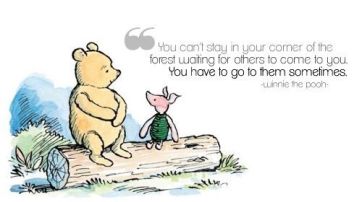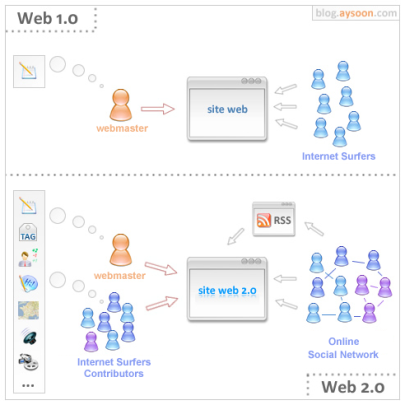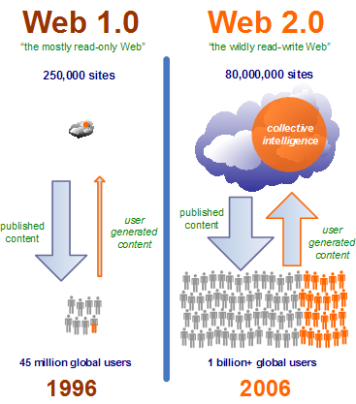“We need, first, to take charge of our own learning, and next, help others take charge of their own learning. We need to move beyond the idea that an education is something that is provided for us, and toward the idea that an education is something that we create for ourselves. It is time, in other words, that we change our attitude toward learning and the educational system in general” (Downes, 2010, para 16).
The concept of socialisation in learning has long been acknowledged as essential to knowledge building and attainment in the field of education (Belbase, 2011, p.3; Cobb, 2005, p.41; Dewey, 1910; Perkins, 2009, p.7). In the Digital Age, as educators and students alike begin to favour models of connected learning over the static environment of the traditional classroom, socialisation in learning has begun to establish itself through the use of social media and networking applications, “a group of Internet-based applications that build on the ideological and technological foundations of Web 2.0, and that allow the creation and exchange of user-generated content” (Kaplan and Haenlein, 2010, pp. 61). These innovations and technological developments that allow for online collaboration and socialisation, enable us to expand our knowledge-building ecosystems and move away from the concept of the classroom teacher as the owner of all knowledge and information (Pink as citied in Bingham & Conner, 2010, loc. 177).

Moving away from traditional model of learning where the teacher acts as holder of all knowledge to a social, networked approach to learning where all participants are part of the learning process (Grout, 2013).
Thus as educators, whether we like it or not, we must embrace social media and networking within our own learning ecologies so that we can extend these learning opportunities to our students of the Digital Age. Just as businesses of the twenty-first century have been forced to up-skill and transform their business models to avoid losing currency, educators cannot ignore the pull of social media and networking to meet the natural drive of socialisation as these emerging technologies, “allow us to embrace the needs of changing workplace demographics and enable people of all ages to learn in ways that are comfortable and convenient for them” (Bingham & Conner, 2010, loc. 184). In echoing the sentiment of Downes when he suggests we must first take charge of our learning before assisting others with their learning, the time has come for educators to embrace social media and networking in their own learning so that they can benefit from, participate in and model this learning for both their peers and their students (2010, para. 16). Whereas traditional education has taught us that learning only happens in the classroom, the rise of social media and networking has proven that learning happens in a variety of ways and places beyond the classroom, opening doors for citizens in the digital age to be, “more effective, more knowledgeable, more energised, and more efficient as professional educators,” and ultimately, as learners (Whitaker, Zoul & Casas, 2015, loc. 205).
As Perkins suggests in Futurewise: Educating Our Children For A Changing World, We must consider what constitutes our learning ecology and ‘go beyond’ the world of traditional education to ensure our students are prepared for learning that is ‘lifeworthy’ – “likely to matter in the lives learners are likely to live” (2014, loc 395), and ‘lifeready’ -“ready to pop up on appropriate occasions and help make sense of the world” (2014, loc 694). This learning will only be possible when we consider learning collectives in networked environments, rather than learning in our traditional hierarchal classrooms (Schravemade, 2015, para. 4).
What is different about teaching and learning using social media and networking is that we are working in environments that we cannot control. The traditional learning relationships we had with our peers and students took place in physical environments, however in the digital age, they are happening in front of an audience we cannot monitor, mandate or select. The notion of connected learning is not one we can learn from a textbook, it involves educators stepping out of their comfort zone and, not only reading or viewing the work of students, but adopting a mindset that places them in the position of learner as they participate in the processes involved with, not only their individual learning, but also that of their peers and students (Whitaker et al., 2015, loc. 248). If, “social learning happens using social media tools and through extended access and conversations with all our connections – in our workplaces, our communities, and online. It happens when we keep the conversation going on a blog rich with comments, through coaching and mentoring, or even during a workout at the gym,” as Bingham and Conner suggest in The New Social Learning: A Guide to Transforming Organizations Through Social Media, then we as educators must ourselves be comfortable with and understand how to participate in such environments (2010, loc. 340).
This is where teaching and learning using social media and networking constitutes a serendipitous relationship with educators. Piaget asserted that, “cognitive conflict created by social interaction is the locus at which the power driving intellectual development is generated” (Perret-Clermont, 1980, p. 12). In this sense, cognition is a collaborative process, and the mind of the learner creates meaning, knowledge and understanding through dialogue, interaction and conversation with others (Ernest, 1995). Research such as that by Bell, Grossen and Perret-Clermont (1985) affirms this social practice, as they assert that students who are actively engaged in working with their peers display greater cognitive growth than those working alone. This promotes the idea that, “personal experiences of individuals become social and collective experiences when they are shared, interacted, and retained as knowledge” (Belbase, 2011, p.3). It is essential then, that as educators we examine how our pedagogy encourages students to participate and be guided by others in their learning. In the twenty-first century, we must embrace trends in technological development such as social media and networking to provide learning experiences reflective of the Digital Age. It becomes innate for educators to continue their serendipitous relationship with socialisation in learning through the participatory culture that is social media and networking.
In the video below, Helen Haste articulates the collaborative nature of information gathering and knowledge development in the twenty-first century (2009).
Social media and networking present the perfect platforms to encourage collaborative an co-operative perspectives through technology use. It is our role as educators to embrace these in our learning so that we can model, participate in and extend this opportunity to our students. The first step in this process as educators is to become digital citizens and connected learners ourselves, so that we can effectively and successfully extend this opportunity to our students. The interactive infographic ‘Getting Started With Digital Citizenship: Social Media and Networking’ shared in a previous post provides a bank of resources for educators to use as a guide when they begin their journey as connected learners, exploring digital citizenship through social media and networking.
Reference List
Belbase, S. (2011). Radical versus social constructivism: dilemma, dialogue, and defense [Online Submission]. Retrieved from ERIC database. (ED525159).
Bell, N. Grossen, M. Perret-Clermont, A.N. (1985). Sociocognitive conflict and intellectual growth. In M.W. Berkowitz (Ed.), Peer conflict and psychological growth. San Francisco: Jossey-Bass.
Bingham, T., & Conner, M. (2010). The new social learning: A guide to transforming organizations through social media [Kindle edition]. Retrieved from http://www.amazon.com/The-New-Social-Learning-Organizations/dp/1605097020
Cobb, P. (2005). Where is the mind? A coordination of sociocultural and cognitive constructivist perspectives. In C. Twomey Fosnot (Ed.), Constructivism: theory, perspectives and practice (2nd Ed.). New York, NY: Teachers College Press.
Dewey, J. (1910). How we think. Boston: DC Heath.
Downes, S. (2010). A world to change. Huffpost Education. Retrieved from http://www.huffingtonpost.com/stephen-downes/a-world-to-change_b_762738.html
Encyclopædia Britannica ImageQuest. (2015). Open white door floating plaster wall [Photography]. Retrieved from Encyclopædia Britannica ImageQuest http://quest.eb.com/search/165_3338382/1/165_3338382/cite
Ernest, P. (1995). The one and the many. In L. P Steffe & J. Gale (Eds.), Constructivism in education (pp. 459-486). Hillsdale, NJ: Lawrence Erlbaum.
Grout, M. (2013). Teaching strategies [Image]. Retrieved from https://prezi.com/y28yncf_uu4b/teaching-strategies/
Haste, H. (2009, June 25). Technology and youth: rethinking the landscape of education (part 4 of 4) [Video file]. Retrieved from https://www.youtube.com/watch?v=xZt9rEnAvew
Kaplan, A. M., & Haenlein, M. (2010). Users of the world, unite! The challenges and opportunities of social media. Business Horizons, 53(1), 59–68. doi:10.1016/j.bushor.2009.09.003
Perkins, D. N. (2009). Making learning whole: How seven principles of teaching can transform education. San Francisco, CA: Jossey-Bass.
Perkins, D. (2014). Future wise: Educating our children for a changing world [Kindle edition]. Retrieved from http://www.amazon.com/Future-Wise-Educating-Children-Changing/dp/1118844084
Perret-Clermont, A. N. (1980). Social interaction and cognitive development in children. Academic Press.
Schravemade, K. (2015, March 29). ‘Lifeready’ and ‘Lifeworthy’ learning: go beyond the traditional [Web log post]. Retrieved from https://theprivateteacher.wordpress.com/2015/03/29/lifeready-and-lifeworthy-learning-going-beyond-the-traditional/
Whitaker, T., Zoul, J., & Casa, J. (2015). What connected educators do differently [Kindle edition]. Retrieved from http://www.amazon.com/What-Connected-Educators-Do-Differently-ebook/dp/B00ULQN564/ref=tmm_kin_title_0?_encoding=UTF8&sr=8-1&qid=1428829250




